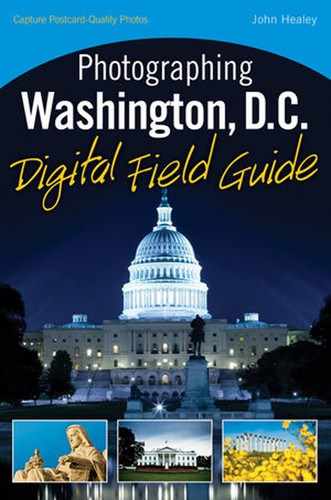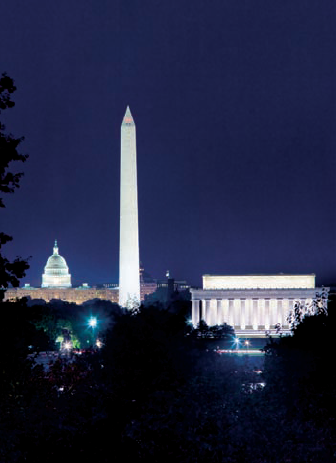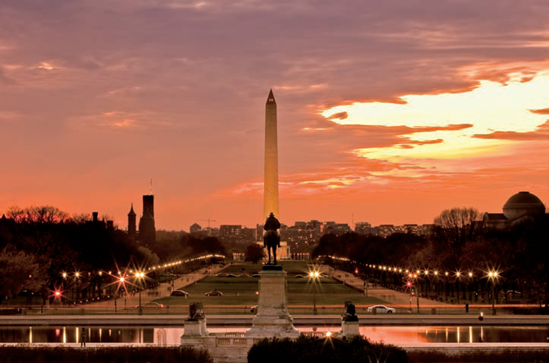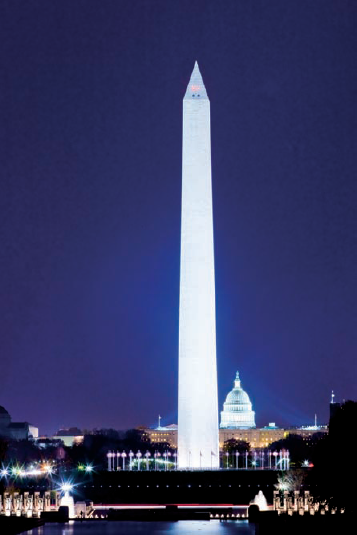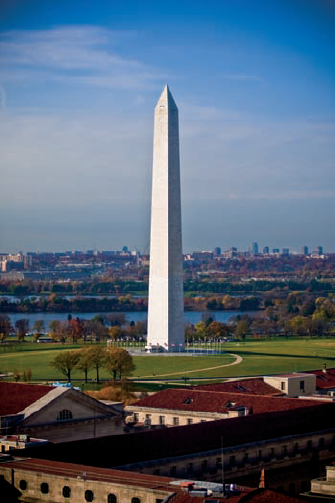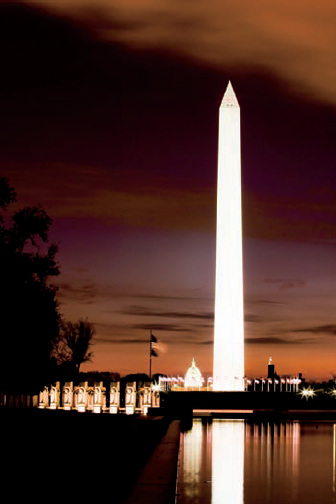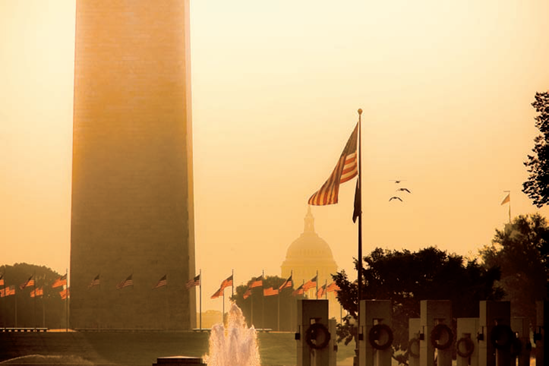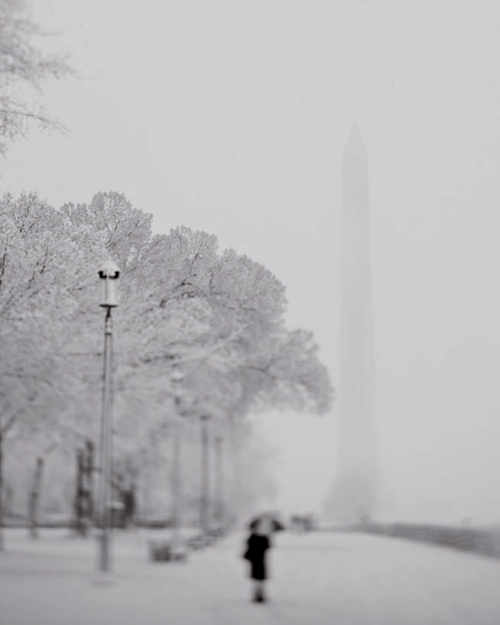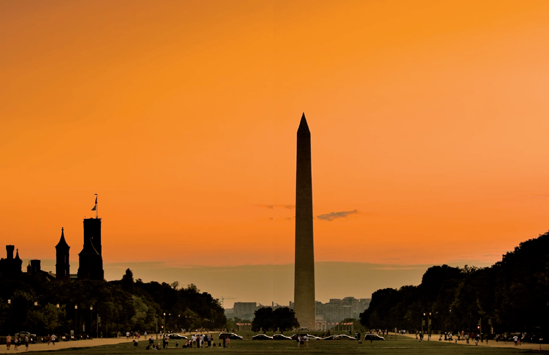
Looking west on the Mall during an August evening. Taken at ISO 320, f/4.5, 1/200 second with a 130mm lens.
The National Mall is an essential part of the United States' collective being. It is where the documents that formed the nation and defined the rights of those who live under its flag are kept. The Mall is where the memorials to those who founded the country are and where those who have fought to protect it are remembered. The nation's collection of art, culture, and wisdom are exhibited and protected at the Mall. Definitive protests and infamous speeches here have altered the consciousness of the country forever.
There are a few classic places from which to photograph the National Mall, and there are hundreds more great vantage points to find as well.
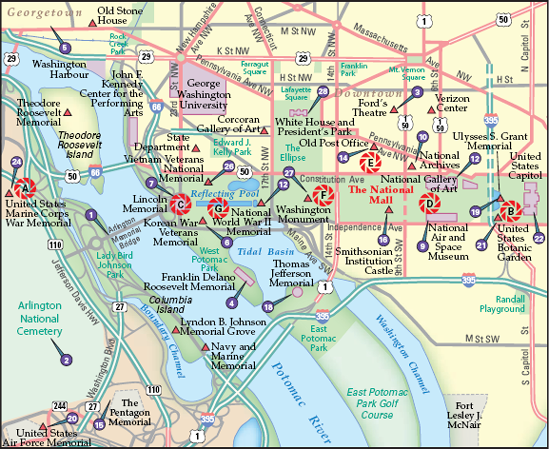
Figure 11.1. The best locations from which to photograph the National Mall: (A) south of the U.S. Marine Corps War Memorial, (B) the west side of the Capitol, (C) the southeast corner of the Lincoln Memorial, (D) between 3rd St. NW and 14th St. NW within the Mall, (E) the Old Post Office Tower, (F) atop the Washington Monument, and (G) next to the Lincoln Reflecting Pool. Nearby photo ops: (3) Ford's Theatre, (9) National Air and Space Museum, (10) National Archives, (14) Old Post Office tower, (16) Smithsonian Institution Castle, (19) Ulysses S. Grant Memorial, (21) United States Botanic Garden, (22) United States Capitol, (27) Washington Monument, (28) White House and President's Park.
Perhaps the best location from which to photograph the iconic skyline of the National Mall, here you can line up the Lincoln Memorial, Washington Monument, and Capitol all in one shot (see Figure 11.1). There are several ways to compose this image just a short walk from U.S. Marine Corps War Memorial.
At the base of the Capitol's west side, you can look out over the Ulysses S. Grant statue, the Washington Monument, and the Lincoln Memorial (see Figure 11.2).
From the Lincoln Memorial, you can get a spectacular view of the World War II Memorial, Washington Monument, and Capitol all in one picture (see Figure 11.3).
The Mall can vary from having hundreds or thousands of people on it to being almost desolate, depending on when you go.
There are plenty of interesting locations within this 11-block area where you can use the Capitol, Washington Monument, or other landmarks in your compositions (see Figure 11.4), especially during interesting weather.
You'll see several different angles of Washington, D.C. and the National Mall from the heights of the 315-foot clock tower at the Old Post Office (see Figure 11.5).
The ultimate view of the National Mall, as well as Washington, D.C., can be seen from the top of the Washington Monument, the tallest structure in the District (see Figure 11.6).
There is a variety of ways to view the skyline of the National Mall from the reflecting pool next to the Lincoln Memorial (see Figure 11.7).
These iconic photographs are perhaps the best way to see D.C., and they are all fairly simple to capture as well.
The National Mall is wide open as far as photo possibilities, whether you are going for iconic images of the landmarks or more subtle detail images around the Mall.
The photographs from the U.S. Marine Corps War Memorial (refer to Figure 11.1) require the longest lenses of all these locations. Somewhere from 250–300mm is a good focal length, although scenes here could be photographed with a shorter lens and still work to some degree.
From the west side of the Capitol (refer to Figure 11.2), a 150mm lens works well to get a tight enough shot of the Mall to read well.
From the Lincoln Memorial (refer to Figure 11.3), a 200mm lens works well. You can go wider or looser depending on your preferences and the conditions at the time.
Photographing the Mall between 3rd and 14th St. is really open to your individual interpretation (refer to Figure 11.4). Lenses from 50–100mm can be used to good effect to select a specific area of the vast landscape here. A good rule when faced with wide-open spaces and/or busy scenes is to select one area to focus in on that can represent the whole. One big, wide shot can often leave a little to be desired in a photograph because there's no clear subject represented.
Tip
A tilt-and-shift lens was used for Figure 11.4. This lens tilts and shifts the elements within the lens to create different types of depth of field depending on how the lens is adjusted. You can make similar effects using a filter within an image-editing program.
When photographing from the Old Post Office tower (see Figure 11.5), you are presented with one challenge: There are steel wires covering the windows here. Although image quality may be lessened, there are a few tricks to getting around the steel wires:
Use a long focal length lens, something preferably longer than 50mm.
Get as close to the wires as possible. It seems counterintuitive, but the closer the wires are to the lens, the less contrast the lens picks up on them and the less you'll see them.
Use the lowest aperture value your camera has, such as f/2.8 or f/4. Doing so limits the depth of field as much as possible and minimizes the distraction the wires can cause to an image.
Also, you may want to concentrate your efforts on the windows that have no sun hitting them directly — the brighter the wires are, the more they will impair the image. The wires reduce the contrast within your image, which you may need to adjust later in a photo-editing program.
There are several creative possibilities from the top of the Washington Monument (refer to Figure 11.6) that can vary from wide to longer focal lengths, but using a moderate length lens, such as a 35–70mm, is a good idea. These come somewhat close to representing what our eyes see naturally and, therefore, give a good feeling of the view from the monument. They also reduce some of the issues with photographing through the often murky glass here.
Next to the Lincoln Reflecting Pool, you want to use longer lenses to pull all the elements together — something from 70mm all the way up to 300mm works, depending on your composition (mainly how much of the Washington Monument you are getting in the image — see Figure 11.8 for an example).
You can bet that with compositions as varied as they are at the National Mall, there are times to use a polarizer and graduated neutral density filter. Both can be used to help increase contrast and even out exposures of the sky and ground.
Using a glass or digital graduated filter for images from the top of the Washington Monument will often be necessary, but of course it depends on what the light is like. From this vantage point, using a digital warming filter or setting your white balance to the cloudy setting can also help deal with the less-than-ideal glass you'll be shooting out of.
In general, tripods are permitted to be used briefly on the Mall, provided they are not an obstruction. However, next to the U.S. Capitol they require a permit. See this book's Introduction for more information on tripod use.
For the image from the west side of the Capitol as well as from the southeast corner of the Lincoln Memorial, using a tiny table-top tripod for these photos is convenient. (Full-size tripods aren't allowed in either location.)
Because of the Washington Monument, most of these images have a large amount of sky in them, which means potentially throwing off your camera's light meter. When adjusting your exposure, try to look for the areas of the image that are closest to a neutral gray in brightness. Sometimes this may be the grass on the National Mall, or it could be an overall scene of buildings. Either way, look for such an area to get a starting exposure for a scene.
For example, from the Washington Monument looking down toward the White House (see Figure 11.9), you can point your camera straight down at the expanse of grass below you and figure out a good exposure there.
Then you can either set that exposure by using your camera's Exposure Lock function, or you can note what it is, flip your camera to manual, and dial in the settings yourself. This way, when you recompose to let a lot of sky in the image, the ground areas don't go too dark. (You may want to further adjust the exposure to limit the brightness of the sky, as well.)
Tip
Depending on the time of day, it may be impossible to get both the ground and the sky well exposed due to the limitations of the camera's sensor.
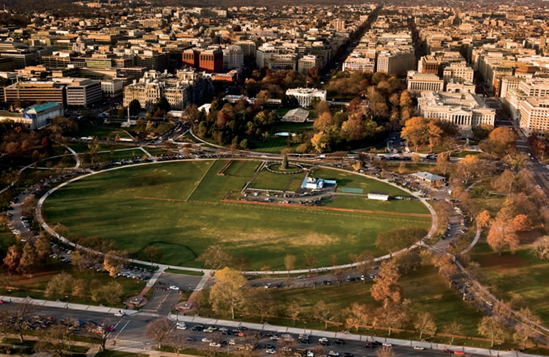
Figure 11.10. The view of the White House and President's Park South (also known as the Ellipse) on a fall afternoon (see F on the map). Taken at ISO 320, f/8, 1/80 second with a 50mm lens.
It's a good idea to set your camera to Aperture Priority mode and use a low aperture value such as f/4 or f/5.6 to minimize the glare from the Washington Monument's windows.
When photographing from the top of the Old Post Office tower (refer to Figure 11.5), use a low aperture value, such as f/4, when shooting through the wires here. This will help to further blur them out when they are close to your lens.
Early morning and late evening are hands-down the best times to photograph the Mall area. When you do, the scene will change every few minutes rather drastically — so plan on taking a lot of photographs in a short period of time.
When photographing from the top of the Washington Monument, things get a bit difficult. For starters, following the notion of when the good light is — morning and evening — doesn't always work as well here. The reason is that the windows at the Washington Monument have a fair amount of, for lack of a better term, environmental crud on them. When the morning or evening sun strikes them, the light gets diffused all over the window, which means that your images will lose a tremendous amount of contrast. You must find either a cleaner area to shoot from or avoid those areas that are being hit directly with the sun. For this reason, visiting here during midday, or when the sun isn't at such an angle that it's directly shining on the windows, is a good idea to get photos from all four vantage points.
Either way, you will likely have to increase the contrast of your images in post-processing to deal with shooting through the glass here. Also, black-and-white images work well from the Washington Monument because of the color shifts that happen from the glass and lack of contrast.
Also note that the Lincoln Reflecting Pool is drained occasionally. When it was completed in 1930, it was made without any circulation system that would prevent problems that arise with stagnant water. Therefore, approximately three to four times per year the Reflecting Pool is drained so that National Park Service workers can clean the area of leaves and litter and refresh the water. It is commonly done in the fall (after much of the leaves have fallen), as well as the hottest parts of the year (July or August), and then one to two other times as it's needed.
Weather at the National Mall can vary from blistering hot and humid to finger- and toe-numbing cold. Whenever you go, be prepared for a lot of walking. The Mall is vast, so if you're trying to cover a lot of ground in hot or cold weather, be prepared.
Some of the most unique images from the Mall happen during interesting weather: Snow (see Figure 11.10), rainstorms, and big weather fronts make for unique photos, whether they are of the landmarks or images from within the Mall.
Night and low-light times are full of potential at the Mall. The monuments stand out brilliantly in the night sky, and fewer distractions are around them. During the weekends and non-working hours there are also many people out on the Mall, which helps to add a sense of scale to photographs here.
